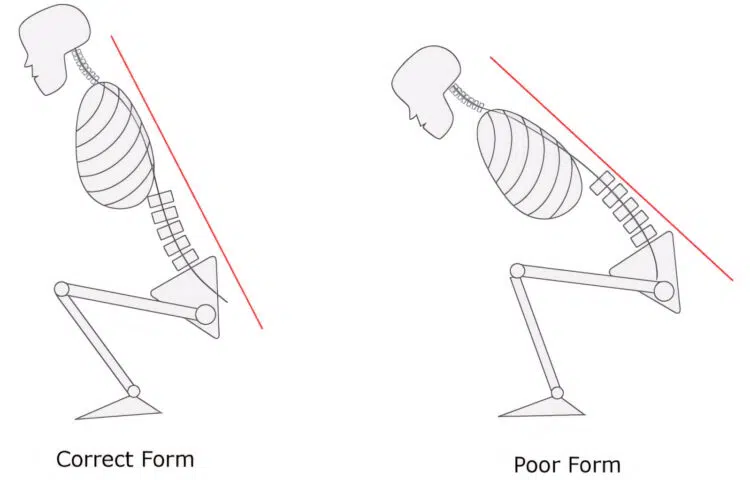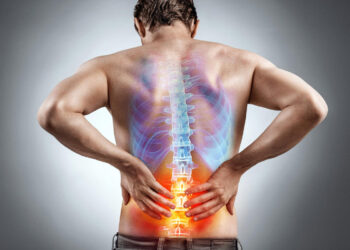Bodybuilders tend to train different muscle groups on different days. They’ll have a leg day, a chest day, an arm day, and so on, following what is commonly known as a split routine. While this is an effective approach for building bigger muscles, it’s not the only way to organize your workouts.
I’m a veteran personal trainer with over 30 years of experience, and while I have nothing against bodybuilding-style routines, I often use a different approach with my clients.
Instead of having an arm day, a back day, etc., I plan my clients’ training programs around movement patterns. This, in my opinion, trains the body as it works in nature. While this approach could be described as functional strength training, it still manages to build an athletic physique with good aesthetics.
For my clients – that’s a win-win!
There are lots of recognized movement patterns, but I generally build my training plans around the following:
- Pushing
- Pulling
- Squatting
- Hip hinging
- Lunging
- Twisting
- Carrying
I call these movement patterns “The Magnificent Seven” and, between them, they provide a balanced workout that trains every important muscle in your body. That said, of these seven, the hip hinge is arguably the star of the show. Exercises that involve hip hinging have the power to transform your body and protect you from injury.
Level Up Your Fitness: Join our 💪 strong community in Fitness Volt Newsletter. Get daily inspiration, expert-backed workouts, nutrition tips, the latest in strength sports, and the support you need to reach your goals. Subscribe for free!
In this article, I explain why hip hinging is such an important movement and reveal the essential hip hinge strategies that can elevate your lifting from novice to pro.
Hip Hinge 101
Imagine bending forward to touch your toes. Most people perform this movement by rounding their lower back. Unloaded, this is a relatively low-risk movement. However, done with a heavy load or repeatedly, it can cause serious injury.
Studies suggest that leaning forward with a flattened or rounded lumbar curve puts tremendous stress on the intervertebral disks and ligaments of the lower back (1). These structures are easy to injure and slow to heal, which helps explain why low back pain is such a common problem that affects as many as 80% of all adults (2).
In contrast, hip hinging – as the term suggests – involves leaning forward from the hips with minimal movement of the lower back. This keeps the stress on your muscles and away from those injury-prone disks and ligaments. This is a much safer maneuver and also makes better use of your muscles so you can lift heavier loads with less effort.
In addition to being the safest way to lean forward and lift, hip hinging is also the most effective way to build and strengthen your posterior chain. This is the collective name for the muscles on the back of your body.
The main muscles that make up the posterior chain are:
- Gluteus maximus
- Hamstrings
- Erector spinae
Consequently, every exerciser needs to master the hip hinge. In fact, it’s one of the first things I teach my clients. A good hip hinge lowers your risk of lower back injury and ensures that you’ll develop a head-turning posterior chain.
But which strategies are best for learning the hip hinge and building the posterior chain of your dreams? All is revealed in the next section!
Five Essential Hip Hinge Exercises
There are many hip hinge strategies to choose from, but in my experience, these are the essential ones that can help you elevate your lifting from novice to pro. I’ve presented them in order of difficulty, from least to most challenging, to make it easier to choose the right approach for your needs and goals.
However, with all these strategies, you must remember one thing: Do NOT round your lower back!
Your lumbar spine should remain neutral (slightly arched) throughout each and every rep. Reduce your range of motion, use less weight, or switch to another exercise if your lower back starts to round. Tight hamstrings and a weak core are also common causes of lower back rounding, so consider addressing those issues if necessary.
1. Mastering the Prisoner Good Morning
The prisoner good morning is so-called because a) it’s done with your hands clasped behind your head and b) you look like you are bowing to greet someone. Obscure names aside, this bodyweight exercise is a great introduction to hip hinging, as the absence of any external load means you are free to focus on mastering the movement.
Once you have perfected this movement, you’ll be ready to move on to more challenging strategies that involve extra resistance.
Steps:
Level Up Your Fitness: Join our 💪 strong community in Fitness Volt Newsletter. Get daily inspiration, expert-backed workouts, nutrition tips, the latest in strength sports, and the support you need to reach your goals. Subscribe for free!
- Stand with your feet about hip-width apart, knees slightly bent.
- Clasp your hands behind your head and press your elbows out and back.
- Brace your core and pull your shoulders back and down.
- Push your butt back, lean forward from the hips, and lower your chest toward the floor.
- Lean as far as you can without rounding your lower back.
- Drive your hips forward and stand back up.
- Reset your core, take a breath, and repeat.
Tips:
- Do this exercise with your back to a wall. Push your butt toward the wall and imagine trying to touch it to maximize posterior chain engagement.
- Shift your weight onto your heels to emphasize your posterior chain. Do not let your weight move forward onto the balls of your feet.
- Cross your hands over your shoulders if the classic “prisoner” arm position is uncomfortable.
2. Incorporating the Banded Good Morning
Weighted good mornings are traditionally done with a barbell. While the barbell good morning is an effective exercise, it can be risky – especially if you are still mastering the hip hinge. Holding a barbell on your shoulders creates a long lever to your lower back, making it much harder to maintain a neutral spine, even with a relatively light weight.
Using a resistance band is a better option because the load is lowest when your spine is in its weakest position, i.e., leaning fully forward. The tension then increases as you stand up and move into a more stable position.
Steps:
- Stand with your feet about hip-width apart, knees slightly bent.
- Place your resistance band under your feet and over the back of your neck.
- Push your butt back, lean forward from the hips, and lower your chest toward the floor.
- Lean as far as you can without rounding your lower back.
- Drive your hips forward and stand back up.
- Reset your core, take a breath, and repeat.
Tips:
- Start with a light/thin band – this exercise is a significant step up from bodyweight prisoner good mornings.
- Keep your neck neutral to avoid neck strain. Do not lift your head to look forward as you lean over.
- Hold the band and bend your arms to take some of the pressure off your neck.
3. Utilizing the Cable Pull-Through
Cable pull-throughs are a popular deadlift assistance exercise. Their main advantage is that they are hard on your
Cable pull-throughs are a popular deadlift assistance exercise. Their main advantage is that they are hard on your posterior chain but easy on your lower back. This makes them ideal for lifters who often have to train with fatigued lower back muscles – all those squats and deadlifts take their toll!
No cable machine? No problem – you can also do this exercise with a resistance band, making it a perfect option for home and outdoor workouts.
Steps:
- Attach a rope handle to a low cable machine.
- Stand with your back to the weight stack and astride the cable.
- Pick up the handle and stand with your feet roughly shoulder-width apart, knees slightly bent. Brace your core and pull your shoulders down and back.
- Push your hips back toward the weight stack, lean forward, and reach between your legs.
- Lean as far as you can without rounding your lower back.
- Drive your hips forward and stand back up.
- Reset your core, take a breath, and repeat.
Tips:
- Pause at the bottom of each rep to get a good hamstring stretch and increase exercise difficulty.
- Descend slowly and then stand up more dynamically to maximize muscle engagement.
- You can also do this exercise with a resistance band – like this:
4. Progressing to the Romanian Deadlift
The Romanian deadlift is one of the best hip hinge exercises around. However, it’s surprisingly technical, which is why it appears toward the end of my list. Performed correctly, the Romanian deadlift has the potential to transform your body. However, done badly, it’s a real back-breaker.
Don’t be in a rush to go too heavy too soon – a little weight goes a long way with Romanian deadlifts.
Steps:
- Stand with your feet hip-width apart, knees slightly bent.
- Hold a barbell in front of your legs with an overhand, shoulder-width grip.
- Push your butt back, lean forward from the hips, and lower the bar down the fronts of your legs.
- Lean as far as you can without rounding your lower back.
- Drive your hips forward and stand back up.
- Reset your core, take a breath, and repeat.
Tips:
- Apply gym chalk to your palms or use lifting straps if your hands fail before your posterior chain.
- Use a mixed grip if preferred, switching hands set-by-set.
- You can also do this exercise with dumbbells, like this:
5. Mastering the Kettlebell Swing
Most hip hinge exercises use a controlled tempo. In other words, you lower and lift the weight slowly and smoothly. For example, you might descend for a count of two and stand back up the same way. However, while this is an effective way to train for muscle size and strength, it may not be the best option for increasing athletic performance.
After all, when was the last time you jumped or sprinted slowly?!
The kettlebell swing involves a powerful hip hinge, making it the ideal strategy for athletes and anyone else who wants to add some “zip” to their posterior chain training.
Steps:
- Place your kettlebell on the floor and stand a couple of small steps behind it. Your feet should be roughly shoulder-width apart.
- Bend your knees, lean forward from your hips, and grasp the top of the kettlebell handle. Brace your core and slightly arch your lower back.
- “Snap” the kettlebell backward between your legs.
- Drive your hips forward and swing the weight up to shoulder height. Keep your arms straight.
- Swing your kettlebell back between your knees and repeat.
Tips:
- Make sure most of the movement for this exercise comes from your hips. Avoid turning your hip-hinge swing into a knee-dominant squat.
- Imagine you are jumping forward with each swing to optimize your “hip snap” and maximize posterior chain engagement.
- You can swing your kettlebell up above your head if you wish – the so-called American-style swing:
Closing Thoughts
By mastering these essential hip hinge strategies, you can elevate your lifting from novice to pro level. The hip hinge is the key to unlocking many exercises, including deadlifts, bent-over rows, box jumps, and other popular movements. Incorporating these strategies into your training will make your workouts more effective and help prevent injuries.
So, make sure you master the hip hinge by working through the strategies in this article. As well as teaching you how to hip hinge correctly, each one will help build and strengthen that all-important posterior chain, taking your lifting to the next level.
References:
- Mawston, G. A., & Boocock, M. G. (2021). The effect of lumbar posture on spinal loading and the function of the erector spinae: Implications for exercise and vocational rehabilitation. New Zealand Journal of Physiotherapy, 40(3), 135–140.
- Freburger JK, Holmes GM, Agans RP, Jackman AM, Darter JD, Wallace AS, Castel LD, Kalsbeek WD, Carey TS. The rising prevalence of chronic low back pain. Arch Intern Med. 2009 Feb 9;169(3):251-8. doi: 10.1001/archinternmed.2008.543. PMID: 19204216; PMCID: PMC4339077.










